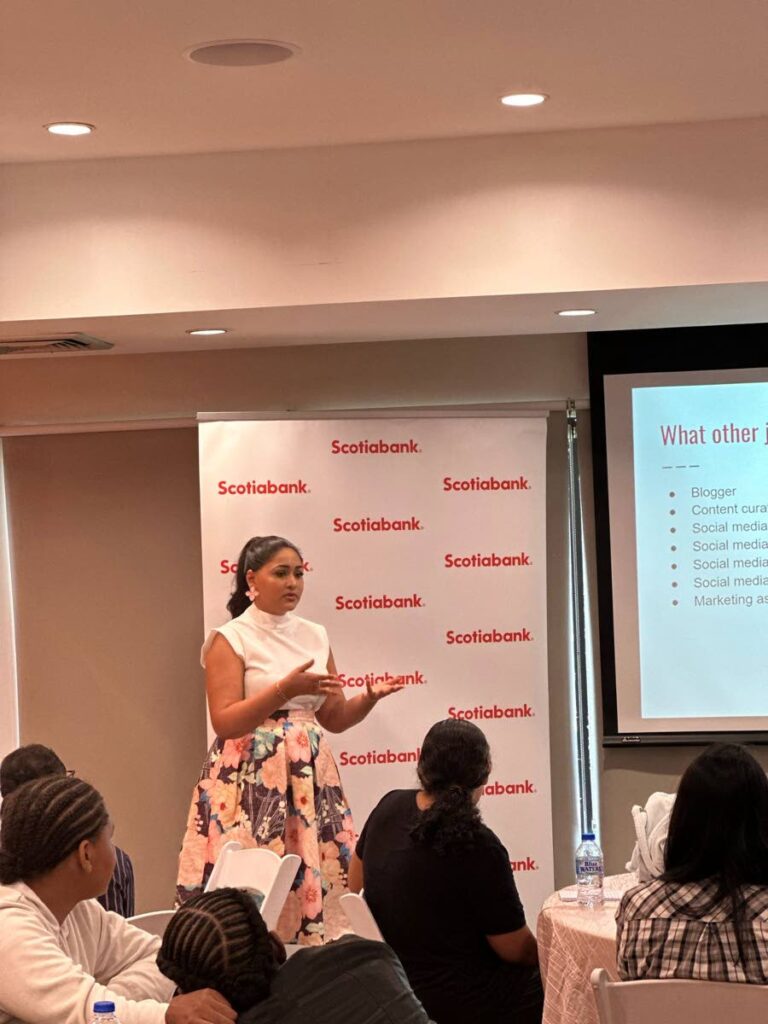What does it take to be an influencer?

TO many of us, social media is a space we use for entertainment, to pass time, stay abreast of news or keep in touch with those close to us.
According to Forbes, in 2023 an estimated 4.9 billion people world-wide use social media – more than half of the world’s population. Your attention and interaction with content on social media attributes to revenue for a select few in the social media landscape. These select few are called content creators or influencers.
The influencer industry is no small part of today’s social media landscape.
In an article in the Harvard Business Review in 2022, Does Influencer Marketing Really Pay Off?, the influencer industry was quoted as a US$16.4 billion industry, and 75 per cent of brands were said to have a dedicated budget for influencer marketing.
But how does influencer marketing work in TT, and is content creation a viable option for entrepreneurs?
Business Day interviewed five people who work in TT’s digital media industry to understand the business of content creation in today’s landscape and how influencing works in this country.These content creators were: Keron Rose, a Business Day columnist, digital strategist and e-commerce specialist of eight years; Anastasia Mootoo, a digital content producer and social media consultant of eight years; Ayodele Gomez, a travel content creator of three years; Brent Coutain, head of IuGo Digital for Lonsdale Saatchi & Saatchi; and Darren Hosang-Rudder, co-founder of Restayge, an intermediary that helps connect stakeholders within the influencer space.
Influencers or content creators?
Before there are any discussions about the influencer landscape or the monetisation process, we must first define a content creator and an influencer.
There was a consensus about the definition of a content creator. Each interviewee, in their own way, described a content creator as anyone who creates content such as videos, images and blog posts for consumption.
They believe an influencer is something different.
Rose said, "There is a misunderstanding of what a content creator and an influencer is.

Photo courtesy Kambe Lovelace
"I think everybody is a content creator or can be a content creator. I don’t think everybody is an influencer."
Gomez said, "A content creator aims to create content with the intention of sharing information or their experiences to their audience within a particular niche."
When it comes to someone with the title of an influencer, the consensus was that an influencer is someone who can influence a populace, no matter how big or small.
Coutain, of Lonsdale Saatchi & Saatchi, said, "An influencer is technically anyone who has influence. Your mom is an influencer to you."
But what differentiates a social media influencer from your mom?
There are many factors that together give someone the title of influencer.
Coutain said, "Influencers are able to move the needle on a topic."
This means influencers are able to bridge a gap and help you understand a product or service on a personal level.
Additionally, Rose said, "An influencer is a title that your audience gives you. You can’t self-proclaim that you are an influencer. Once the audience is taking your advice on taking a particular action, then you can be an influencer."
To explain the difference between a social media influencer and a regular consumer, Hosang-Rudder said, "Everyone has influence. Professional influencers just do it at a different level. They are hyper-consumers."
Hosang-Rudder added that one of the defining strengths of an influencer is their ability to relay a message in a way that is unique to them but resonates with their audience.
"Authenticity is the largest value they bring to their audience."
Understanding the local industry
In trying to understand the influencer landscape in 2024, we must first understand the rise of social media and the inception of influencer marketing.
Before the popularisation of social media, companies relied on websites and applications to drive marketing in the digital space.
An influencer in the early 2010s would have been an athlete, soca artist, radio host or notable figure in society. But these prominent figures had a degree of separation from the layman.
However, with the understanding that social media’s base function is people and communities interacting in an educational, joking or satirical manner, this gave rise to early adopters of content creation. Brands saw this as a tactic they could use to further speak to their communities of interest.

Coutain said, "When social media became the forefront for media, people began sharing themselves.We got to a point where your life is literally a mirror of what is being shown online."
Although regular social media users may not have known these early content creators personally, they saw likeness and nuance in them and therefore relatability.
"I might not know you in person but I have an ethos with you," Coutain added. This is the genesis of influence.
An imperative of influencer marketing is working with an influencer who has authenticity in their content, says Hosang-Rudder.
"They bring insight that may not have been available had they not interacted with the product or service."
But other than providing an authentic experience around a product, influencers are a good resource when targeting a specific demographic.
This demographic does not only pertain to age groups or people who like that influencer’s content, but also to influencers who can appeal to a geographical area.
Coutain says influencers are now a tactic used within an overall marketing structure to add a personal feel to a product, service or brand.
But he warned: "Relying heavily on influencer marketing makes brands lose out on an omnichannel approach."
He added that influencer marketing has limited "stickiness" to it, as influencers are human and susceptible to change and mistakes. Mistakes made in the public eye can affect a brand’s integrity.
He also said influencers can delete content once the brand deal has ended, so using influencers as a tactic in a marketing strategy would be most beneficial for brands.
On what brands look for when hiring an influencer, Coutain said, "It’s not just about how many people follow you, it’s how many people engage with your content."

Coutain also listed criteria Lonsdale Saatchi & Saatchi look for when selecting an influencer for a campaign:
- What is the influencer’s engagement rate?
- Are their followers the client’s intended audience?
- Does the influencer fit the brand in terms of the content they produce and past controversy, as well as current and past brand alignments?
To maintain authenticity in the partnership, Coutain says they monitor an influencer’s current and previous brand deals to ensure their client’s marketing initiatives with an influencer resonate. If an influencer has worked excessively with their client’s competitor, that influencer would not be considered a good fit for that brand partnership.
When it comes to sourcing and monitoring influencers’ activities, Coutain said they hired an influencer manager who is "paid to be online."
On providing reports before influencer partnerships, Mootoo said there are sophisticated ways of checking.
"International brands do their checks. Once you type in (an influencer’s) handle, it shows your insights."
However, for local brands she said the process is a bit different, but owing to the set-up of social media currently, an influencer’s metrics are transparent.
"Locally, it’s more about the connection with brands, them trusting you and seeing your content. Now, with how social media is set up, it’s very easy to see the insights of an influencer."
Before content is posted by the influencer it is reviewed by the client and reports are sent by influencer to the brand within stipulated periods, the first being within 24 hours.
How to build a social media brand
Building a brand as a content creator may not seem easy in today’s densely populated social media climate, but our experts shared their stories on how they made an impact.
On equipment, the consensus is that there is no need for fancy hardware and software when starting a content creation journey.

Photo courtesy Kambe Lovelace
Mootoo said, "Just using my iPhone 6 and those phone mounts for cars is really how I got started."
Similar sentiments were echoed by Rose, "I started off with no budget and the only equipment I had was my computer."
As well as Gomez: "I was an Android user creating content from my phone. I would have had a tripod, ring light and my laptop for editing."

The commonality among these influencers is their level of dedication, understanding their niche and ability to provide value in the content they create.
Value for each of them is different.
What Rose aims to do is provide his audience with educational content in the areas of digital marketing.
"My value is in being a resource. I’m always asking myself, ‘How does my content help to solve a problem?’”
Value for Gomez is the experience she takes her followers on, the travel information she provides and the unknown information about a country she highlights.
"For travel-content creation, researching where to go and what to do is very important. Planning is important. The activities and outfits are all planned, but I try to leave some room for spontaneity.
"What I aim to do as well is experience something I can only experience in that country – either an activity or a type of food."
For Mootoo, part of her value comes from the authentic feedback she provides to her followers on a product or service.
"If I genuinely love a product, I would share it with my audience.
"People often think that influencers are paid for every single product that they review, which isn’t true, so I try to balance my posting with paid collabs and unpaid content."
Mootoo said that balancing her social media presence with paid and unpaid content adds to her level of authenticity and validity as an influencer.
When it comes to negotiating brand deals it’s not as cut and dry about the monetary value as one would think.
Mootoo said depending on the requirements of the brand deal, she charges between $4,000 and $6,000 per post.
The influencers said brand deals are negotiated on the basis of the influencer’s alignment with a brand, the budget the brand is working with and also their ethics and values.
They said their interactions with representatives of a brand can go a long way.
"One of the main things that I look for is if the collaboration is within the morals, values and standards I set for myself. What I try to do is look at what their (the brand’s) budget is and how much content they want me to create to decide how I can or if I will go forward with that company," Gomez said.
Mootoo echoed this,saying she "tries to work with the budget that they (the brands) have.”

She also said in her pricing structure she has to factor in shooting time, if shooting at a location is required, editing time and whether additional props are required. In terms of setting a standard for herself and her audience she said she must use a brand’s service at least twice before posting about it, and products are all tested according to their instructed times. This allows her to genuinely see if the product or service works for her.
On costing for a deal, Rose said, “Calculate the cost of what it takes to do what you have to do and multiply that by two, and if that number scares you, that’s the number you should be charging.”
He said to keep in mind that your price tag can always change, as an influencer’s brand value is subject to change based on deals, features or affiliations they are able to acquire.
“The most amount of money I’ve be paid in a single contract so far has been about US $25,000. It was a mix of creation content, speaking, doing workshops and doing one-on-ones with key businesses as well.”
He said a good sign that you are charging correctly is when a company is willing to pay the price you set.
"By midnight December 31 (2023) I’d hit about $600k for this year. That’s up from last year. Last year I hit about $320K, and that was up from the year before, which was about $120k.”
Hope for the future
Given that social media continues to develop on a daily basis, those in the industry hope for a greater understanding of influencer marketing locally both from companies and upcoming influencers.
Rose said content creation is in its infancy in the Caribbean and content creators should understand that there are multiple ways to monetise their platform beyond brand deals.
“Monetisation means a lot of things,” Rose said.
He encouraged content creators to learn about ways to drive sales from a platform, affiliate marketing, dropshipping and building an online presence that will allow the creator to put on their own workshops.
“Don’t just rely on brand deals or trying to get a platform to pay you.”

Hosang-Rudder said with greater access to social media, he believes greater understanding of data will drive the industry’s growth.
He also hopes to see increased understanding that there is value in influencer marketing and that influencers can be an integral tool in achieving beneficial outcomes for a brand.
Last year "was validation for us that there is demand. That brands want to connect with influencers and they want to do it in a much easier, less frictional way. They want to make more genuine connections, they want to do it faster and they are willing to pay for that connection, as well as for the service of influencers."
Click here to read part two of this article.


Comments
"What does it take to be an influencer?"